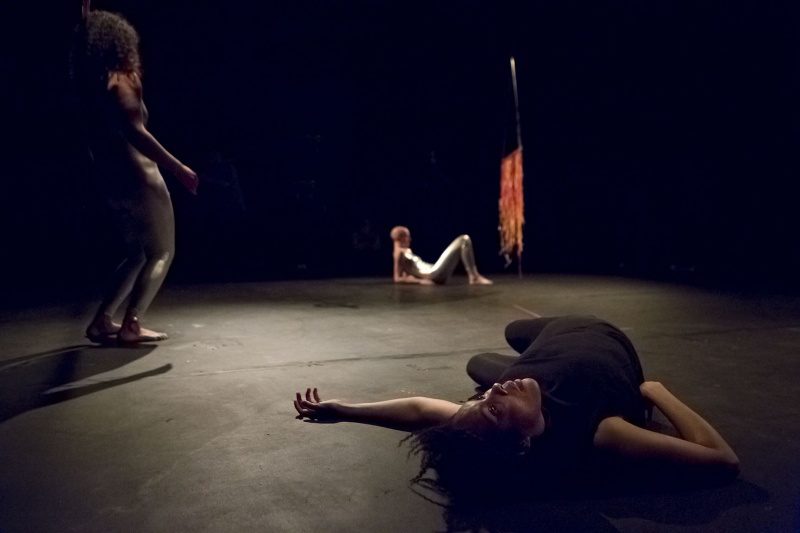In Sonia Boyce's latest presentation, the realms of power and space are closely linked. Here, our author Liese van der Watt reviews the elusive piece, bearing in mind the conditions and the limits of performance art itself.

Sonia Boyce’s We move in her way. Photo: George Torode; Courtesy: the artist and ICA, London
In a week of seeing the art of Richard Mosse, Ibrahim Mohammed, Lubaina Himid, Moffat Takadiwa – all artists whose work references the external world in its political intent – I also go to visit the Institute of Contemporary Arts (ICA) to see Sonia Boyce’s We Move in Her Way. Now, this being the ICA and this being contemporary Sonia Boyce, I am fully expecting to find art that is less overt in intention, more obtuse in reference – in short, art that engages intentionally with an aesthetic avant-garde tradition; in this case, with body art, happenings, and performance art.
And indeed, Boyce has constructed an art work out of a collaborative performance she herself commissioned, which took place at the ICA in 2016 between vocal artist Elaine Mitchener, artist-choreographer-sculptor Barbara Gamper, three dancers, and an invited audience wearing masks reminiscent of Sophie Tauber’s 1920 Dada Head. The performance – unscripted, improvised, engaging with Gamper’s sculptural installations, accompanied by Mitchener’s rich vocal improvisations – was filmed from various angles and provided the material for Boyce’s current solo art work, which is essentially the result of what she likes to call “recouping the remains.”
In this case, a multi-channel projection recoups various extracts, or “the remains,” from the original performance onto two monitors at floor level and screens of various sizes. These are set up across two darkened rooms enveloped in wallpaper printed with a repetitive Rorschach pattern of the dancers’ poses.
The text accompanying the show is sparse, and, judging from the puzzled viewers that watched the monitors with me, insufficient. It tells us that the title “suggests two possible readings: that ‘she’ dictates our gestures and autonomy; or that we obstruct ‘hers’, with both interpretations suggesting authority is at play.” Clearly, this collaboration stands in a long tradition of movement and performance art and perhaps even gestures to what the Photographer’s Gallery recently called the “Feminist Avant-Garde.” It negotiates authority and power, relying on chance encounters between bodies and the sculptural objects initiated by the spandexed dancers and responded to by the masked audience.
In order to really “get” the performance, one would probably have needed to see it. This, of course, is often the case with performances (and sometimes precisely the point of them) but here we have the added dimension that what we are watching is not simply a documentation of the original performance, but an art work made from the remnants of the performance. Yet, as a sensory experience – which Boyce’s work clearly tries to be by virtue of the darkened room, the haunting soundtrack, the movements of the bodies, the strategically placed monitors encircling the viewer – the work falls short. The audience remains mostly unmoved, passive, and excluded from the original context and what may have been an energizing and boundary-pushing experience.
To make sense of it at all, it would have helped to know a bit more about the various collaborators. For instance, Elaine Mitchener collaborated with Boyce at the Venice Biennial in 2015 and her boundary-defying vocal art uses spontaneous voice to confront our inhibitions around notions of the self. While none of this information is provided at the ICA, Mitchener’s own website offers a far more elucidating description of her part in the performance: “I was commissioned by the artist Sonia Boyce to create ‘I back…I neck…I face…I chest’ a 20 minute ‘anonymous exploration of identity through movement, sound art and vocalization.’”
Despite Boyce’s long interest in improvised collaborative work, with this little information on the collaborators the collaborative part of this art work doesn’t become very apparent. Moreover, we cannot access the thrill of an unscripted performance. There may have been a conscious decision to keep clarifying notes to a minimum in order for the viewers to “experience” the art work more directly, but it also means that viewers are left without any orientation on how to look at the performance.
The original performance may have meant something to the participants, but the remnants of the performance used in the final solo art work feel inaccessible, just too distant to be recouped in a meaningful way.
Based in London, Liese Van Der Watt is a South African art writer and associate editor of C&.
More Editorial